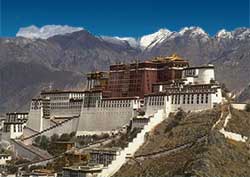potala palace
 Why the
Potala Palace
in China is special
Why the
Potala Palace
in China is specialThis massive palace (now a museum) in Lhasa, Tibet was once the winter religious and political seat of Tibet under the leadership of the Dalai Lama.
Potala Palace tips and insights
Pronunciation
The name Potala is pronounced: poh-TAH-lah
Spiritual ambiance
The Potala Palace's interior is today filled with the same sounds (chanting) and scents (incense and yak-butter burning lamps) that visitors encountered centuries ago.
Once the world's tallest
The Potala Palace was the world's tallest occupied building from 1653 to 1889.
Stairs only
The 13-story Potala Palace has no elevator. There are three sets of stairways, which are steep and ladder type. Only the Dalai Lama was allowed to use the middle one.
Great views
The views from the Potala Palace's roof and balconies are spectacular. Below lies Lhasa city and, beyond, the valley countryside and distant snow-capped Himalayan mountains.
Altitude
The Potala Palace is 3,700 meters (12,000 feet) above sea level. Therefore, it is advisable to rest during your first day in Tibet to acclimate yourself to the thin air before exploring the Potala Palace.
Two palaces
The 1000-room Potala Palace is really two palaces: A red one at the top and a white one below it (see photo on page one).
- Red Palace
It is used for religious purposes. It has chapels, shrines and prayer halls. It also contains sacred scriptures, outstanding murals, and the gold covered stupa tombs of eight Dalai Lamas.
- White Palace
This was used for secular functions. Its facilities included bureaucratic offices, monk dormitories, a seminary, and the Dalai Lama's living quarters.
The Potala Palace has outdoor ramp steps skirting its flanks.
Construction
The current building was constructed in the 17th century on the foundation ruins of a fortress palace built a thousand years earlier.
Sloping cliff
The cliff face behind the front bottom half of the Potala Palace slopes backward. This enables the hill to bear some of the building's massive gravity induced weight load. The architects added more support by embedding some of the building's structural beams into the cliff.
Location in China



